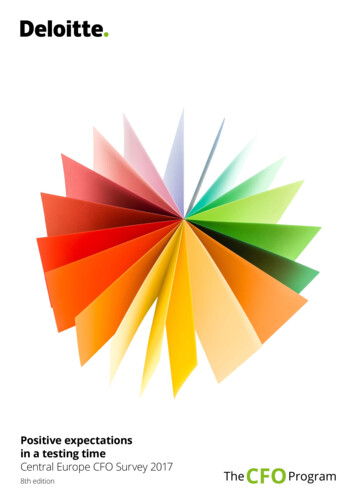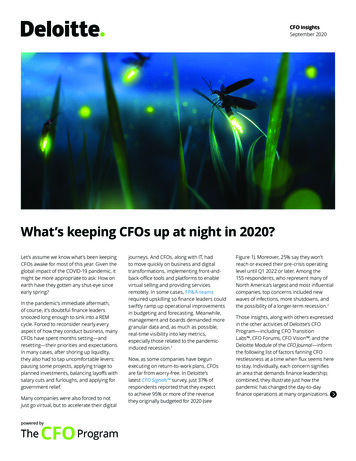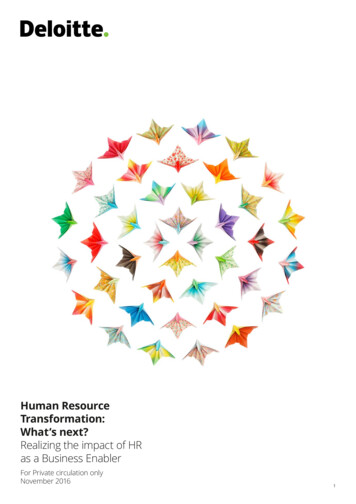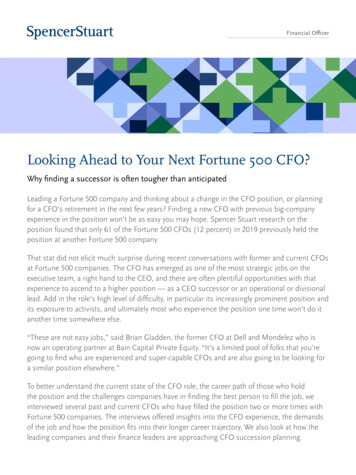
Transcription
The Deloitte/SEB CFO SurveyFinding the Rhythm and the CourageSpring 2015
Contents3Introduction4Summary6Hot Topic7Business Confidence8Prospects and Concerns11Finance13Macroeconomic Context15Contacts
Welcometo Deloitte/SEB CFO SurveySpring 2015We are excited to present the spring 2015 results of the new Deloitte/SEB CFO Survey.The report uniquely combines perspectives from CFOs within large and midsizedcompanies in Finland with viewpoints from SEB’s Nordic Outlook, SEB researchteam’s flagship report on key forecasts and global economic trends.For the first time, the survey was conducted simultaneously in other Europeancountries and thus we were able to make valuable comparisons between Finnishand other European CFOs. The European CFO Survey is part of a global cohort ofsurveys benchmarking the attitudes and future intentions of Chief Financial Officers,gathering views from over 1,300 CFOs in 14 European countries.We hope that you find the results and our analysis both stimulating and valuable.Please send us all feedback together with any suggestions for improvement.Tuomo SalmiPetri HeinonenPartner PartnerCFO Program LeaderFinance Transformation LeaderDeloitte DeloitteVille LähdeFinancial StrategyCorporate CoverageSEBCFO Survey Finding the Rhythm and the Courage3
SummaryThe uncertainty facing the economic recoveryis not lowering the expectations the ChiefFinancial Officers in Finland have regardingabilities to improve the financial performanceof their companies. According to the first quarterDeloitte/SEB CFO Survey, Finnish-based companies arein a position where they have mostly completed thepost-financial crisis restructuring. The risks on balancesheets are sinking and fewer companies are decreasingtheir workforce on a global scale. The outlook onhiring is balanced, but still we have not seen the lastof the job cuts in Finland as 25% of the companies willdecrease the amount of employees working for them inFinland in the next 6 months.Regardless of the positive signals, the dualityof business strategies still exist. Finnish CFOs arewilling to make strategic investments and businessstrategies emphasizing growth are at reasonablypositive levels. On the other hand, they are risk-averseand 40% of the respondents of the survey are alsoemploying defensive strategies such as cost-reductionand increasing cash flow.This time, CFOs were asked specific questionson how would they resolve the pan-Europeangrowth crisis and what decisions the Finnishgovernment should make as soon as the newgovernment is formed. From the plethora of options,our respondents seem to mostly agree that firstlyFinland needs assertive structural national reforms andfast decision-making during the next six months or thesentiment is going to turn more pessimistic. On theother hand, Finnish CFOs don’t think that dissolvingthe Euro, redistributing political powers to nationalgovernments or deepening the fiscal and politicalunion would make a great difference in resolving thecrisis. While it is clear that something should be done,our respondents can’t find a consensus on the methodsof improving the economy. Reducing the governmentspending, balancing the budget and reducing taxesbeing the traditionally favored options, we alsoreceived strong support for boosting the investmentsand initiatives. As much as 55% of the respondentsthought that stopping austerity programs and boostingfiscal spending would be a good method to resolve thecrisis.The results of the first quarter survey bring us aset of encouraging signs that Finnish companiesare on a path to improve their revenues, cashflow and operating margins altogether. Thismakes Finnish CFOs more optimistic than ever inthe past four years surpassing the UK and Europeanregion’s outlook in the same metrics. Finnish CFOs havealso a higher level of certainty about the financial andeconomic development than CFOs in the Europe regionhave in general. This is interesting, due to the factthat the Finnish economy will likely grow slower thanthe rest of the Eurozone and CFOs are still agonizinglyworried about the demand and the outlook of theFinnish economy.The prolonging geopolitical crisis and lastingheavy sanctioning policy on Russia havedepressed the growth expectations in Russiaand none of the respondents were increasingtheir presence in Russia. Yet, the great majority ofCFOs said that they have already made the requireddecisions and changes in regard to the Russia-relatedstrategy. The growth opportunities in Russia remainingnext to random Finnish companies are looking to growtheir business elsewhere. The emerging growth inAmerica is expected to have a positive impact on 19%of the respondents’ companies, which is a tremendousleap from last fall when only 8% expected to growtheir business in America.In regard to the valuation of Finnish companies,more than half of the respondents think that thestock market is inflated and Finnish companiesare over-valued. Hence, the Finnish CFOs areaggravatingly negative towards equity as a source fornew funds. Rather, they prefer bank borrowing andcorporate debt. CFOs also expect the M&A market toremain active.4
Ke y findings: The business optimism in Finland ishigher than in Europe. The net businessoptimism is 34%, which is the highest value inalmost four years. 60% of the CFOs are seeing theirfinancial position as favorable. The business environment remainsuncertain, but Finnish CFOs are moreassured than CFOs in the Europeregion in general: 49% of CFOs ratethe uncertainty facing their businesses ashigh—11 percentage points lower than theEurope region in general. In Finland, CFOs regard the Finnishstock market as inflated. 52% of therespondents consider that Finnish companiesare overvalued. 26% of the CFOs are willing to makestrategic investment in Finland in thenext 6 months, if the financial positionremains the same as now. The economic recovery in America isaffecting Finnish companies. 19% of theCFOs think that their company will have thebest opportunities for growth in that specificmarket. The job cuts are not completely over.25% of the respondents’ companies are stillreducing workforce in Finland. National structural reforms are seen asthe most effective way to resolve theEU growth crisis. 100% of the respondentsin Finland are certain of its effectiveness and92% in Europe. Key metrics to improve. 59% of the FinnishCFOs expect the revenues to increase and65% expect operating margins to increase.CFO Survey Finding the Rhythm and the Courage5
Hot TopicThe CFOs of Finland and Europe are seeing thenational structural reforms as the most effective policyto resolve the current EU/euro-area growth crisis.The CFOs—Finnish CFOs more than their Europeancounterparts—see reducing austerity measures andincreasing public/pan-European spending as a wayout also. The CFOs are generally favoring the currentstatus quo in the centralization of power to theEU. 60% don't want to deepen the integration andsimultaneously 64% don't want to redistribute thepolitical power and responsibilities. On the other hand,European CFOs are significantly more pro-integrationthan their Finnish counterparts, but also more dividedon the subject as they also favor redistributing powersto national governments more than Finns. Generally,global trade agreements (e.g. TTIP) are perceivedto have a positive correlation with resolving the EUgrowth crisis.Chart 1. How effective do you think the following policies would be in resolvingthe current EU/euro-area growth crisis?More national structural reforms to increasecompetitiveness (e.g. labor market and taxreforms, liberalization of service market)Increase public / pan-European investmentspending (e.g. in infrastructure, innovation)Enter into global trade agreementswith other regions (e.g. TTIP)Boost EU single market initiatives(e.g. energy union, single digital market)More aggressive monetary easing by theEuropean Central Bank (e.g. buyingsovereign and corporate bonds)Balance government budgetsand reduce public debtReduce or stop austerity programsand boost fiscal spendingDeepen European integration towards afiscal and political union (e.g. issuanceof Eurobonds)The Finnish CFOs' Top5 policies for resolving thegrowth crisis do not include austerity measures.Reduce number of eurozone membersRedistribute political powers andresponsibilities to national governmentsDissolve the Euro0%20%40%60%80%100%% of Finnish CFOs see as effective or very effective% of European CFOs see as effective or very effectiveIn the aftermath of the parliamentary election held onthe 19th of April, the CFOs see that general politicaldecision-making influences their business environmentquite a lot. They are genuinely interested in thedevelopment of the government budget and thedirection of decision-making. The CFOs find reducinggovernment spending to be the most important taskfor the next Finnish government by a large margin.The next most important tasks were found to belowering tax rates overall and boosting investments,both accelerating the investment environment and toincrease government-managed investments.Chart 2. What is the most important task the next Finnish government shouldpay attention to?Reduce government spendingLower tax ratesBoost InvestmentsMake structural reforms(e.g. social and healthcare solution)Reduce bureaucracy and red tapeIncrease national competitivenessThe government to be able tomake decisionsConservative salary raises024681012Mentions, times6
Business ConfidenceThe net optimism has recovered from the past fall’smomentary lapse and reached the highest levels in thepast 4 years. The optimism in Finland is outstanding(net optimism 34%). This is especially encouraging,because the net optimism in UK (17%) and in the restof the European region (14%) is clearly lower. Thisindicates that CFOs in Finland are confident about theircompanies' financial position and they are undeterredby the uncertainties regarding the recovery of theEuropean and Finnish economy (see the questionregarding greatest concerns).Chart 3. Compared to six months ago, how do you feel about the financialprospects for your ptimisticEurope** European results only available from 2015/Q1-60In spite of the development of the economy in theEuro area remaining somewhat obscure and thelingering geopolitical instability, perceptions on theoverall financial position of CFOs’ own companiesare persistently positive. 60% of the CFOs are feelingconfident about their financial position, indicating thatcompanies have managed the risks well and could beready to be more opportunistic (see preferences touse cash surplus on investments, chart 6). This quarter,especially the manufacturing industry has a favorabletone as 57% of the companies in manufacturing areseeing the position as favorable.Chart 4. The overall financial position of your company is seen ry favorableFavorableAverageNot sofavorableVeryunfavorableCFO Survey Finding the Rhythm and the Courage7
Prospects & ConcernsAs was the case in the earlier studies, the three biggestconcerns for CFOs in Finland are demand, the outlookof the Finnish economy and competitiveness, and thecost of labor. But on the other hand, as the shortgageof skilled labor is falling, also the cost of labor seemsto have decreased. Country risk Russia has taken asmall nudge upwards to 21%. As the geopolitical crisisstabilizes into a standstill and EU sanctions remain level,the situation will probably stay unaltered. It seems thatthe CFOs are turning their focus away from Russia andthe risks involved are being managed comprehensively.Chart 5. What are the greatest concerns for your company in 2015?DemandOutlook of Finnish economyand competitivenessCost of laborCountry risk RussiaForeign competition2015/Q12014/Q3Cost of rawmaterial/commodities2014/Q10%CFOs are less willing to distribute the excess moneyto shareholders and they are becoming increasinglyinterested in making strategic investments both inFinland and abroad. 26% of the CFOs would mostlyprefer strategic investments in Finland and 27% wouldprefer strategic investments abroad. Also paying downthe existing debts remains as the third viable option.20%40%60%80%Chart 6. Assume a current cash surplus position. How would you preferto use the money in the next 6 months?Strategic investment abroadStrategic investmentin FinlandPay down debtDividend to shareholdersFinancial investmentin Finland2015/Q1Financial investment abroad2014/Q12014/Q30%Finnish CFOs are slightly more conservative in theirexpectations for revenue development but, onthe other hand, much more optimistic concerningoperating margins. As with other observationsmade, the Finnish CFOs are comprehensively moreconservative than their European counterparts.At the same time, they do have more trust inthe development of their operating margins.5%10%15%20%25%30%Chart 7. In your view, how are the following key metrics for your companylikely to change over the next 12 months?70%6050403020100RevenuesFinlandIncrease significantlyNo change8RevenuesEuropeOperating marginsFinlandIncrease somewhatDecrease somewhatOperating marginsEuropeDecrease significantly
The CFOs’ expectations for operating cash flowdevelopment are broadly unchanged. Overall optimismstayed on a highly positive level, but will not affectcash flow expectations.Chart 8. Net percentage of CFOs expecting their operating cash flow toincrease over the next 12 months*:80%Increase expected706050403020* The phrasing of the question and the response options havechanged for the 2015 Q1 questionnaire, therefore the resultsare not truly comparable. Yet net optimism stayed relevantas the function of the question remained the same.The balance between CFOs’ prioritizing defensivestrategies and expansionary strategies has remainedsteady. 40% of the CFOs are still mostly prioritizingdefensive strategies, but 33% of all the respondents arealso willing to employ more expansionary Q12014Q32014Q12015Chart 9a. To what extent is each of the following business strategieslikely to be a priority for your business over the next 12 months?50%40302010DefensiveExpansionary0The search for growth is still primarily madethrough expanding organically and by introducingnew products or entering new markets (like theAmericas). However, the focus on new products ormarket introduction are a stronger priority (strongpriority for 48%) now than it was in the fall of 2014(strong priority for 35%). Simultaneously, the relativeweight of CFOs' prioritizing expansion throughacquisitions has dropped from 24% to 15Chart 9b. To what extent is following business strategies likely to be apriority for your business over the next 12 months?Reducing costsExpanding organicallyIncreasing of cashflowIntroducing new products/servicesor expanding into new marketsExpanding by acquisitionIncreasing capital expenditureReducing leverageDisposing of assetsRaising dividends or share buybacks0%Strong priority20%40%60%Somewhat a priority80%100%Not a priorityCFO Survey Finding the Rhythm and the Courage9
The strengthening dollar and positive signals of theU.S. economy have improved the expectations of CFOsin Finland. The number of CFOs expecting growthfrom the Americas has more than doubled, jumpingfrom a moderate 8% to 18.8%. Also 11.5 percentagepoints fewer CFOs are expecting growth from theNordics, although the Nordics is still the primary regionfor growth for 36.9% of CFOs. The overall growthexpectations from Russia have reduced to next tonothing.The survey also included a question* about the stillongoing geopolitical crisis. The answers revealed thatthere has generally been no change in companies’Russia strategy in the past six months. It seems that thesteps needed have already been taken. But still 10%are going to decrease their presence in the Russianmarket. A third of the respondents that chose the“Other, please specify” option elaborated their answersto indicate restructuring of their Russian organizations,which could also mean decreasing their presence in themarket.The number of companies that are going to decreasethe number of their employees in Finland has droppedto a two-year low. And, at the same time, hiringin Finland has increased and hiring abroad hasdecreased, so we could be seeing the end of the majorrestructuring phase and the surge of cooperationprocedures. This can be seen as a beginning for amore balanced phase of investing and growth.Chart 10. During the next 12 months, in what region do you expectyour company to have the best opportunities for dicRussiaOther EMEAcountriesAsia PacificAmericaOther* Question: “Has the current geopolitical instability had any effect on your company'sRussia-related strategy?”Chart 11a. The number of employees working in Finland for your company is,in the next 6 months, expected 5%Fewer companies cut jobs.Still 25% of respondents expectthe number of employeesworking in Finland to decline.The number of CFOs that see their staff numbersgrowing abroad has declined from 31% to 23% and,at the same time, seven percentage points morerespondents felt that their staff numbers will remainthe same as before.100IncreaseBe unchangedDeclineChart 11b. The number of employees working abroad for your companyis, in the next 6 months, expected to:70%2015/Q1602014/Q35040302010010IncreaseBe unchangedDecline
FinanceSince late 2012, when the equity market in the CFOs’regard was the most devalued, more and moreCFOs think that Finnish companies are overvalued.The beginning of 2014 marked the tipping point,because from that point forward we have had moreCFOs thinking that companies are overvalued thanundervalued. Skepticism towards the sustainabilityof the recovery of the stock markets in Finland isincreasing due to the fact that 52% of the CFOsthink that the market is inflated and companies areovervalued and simultaneously the private equityfunding is the least attractive source of externalfunding (see chart 13 [External funding]).Chart 12. How do you currently rate the valuation of Finnish companies?80%Overvalued6050403020100Overall, the CFOs see external funding as a viablefunding option at the moment. Corporate debt andbank borrowing are seen as the most favorable options,whereas equity funding is seen as least appealing.Finnish CFOs favor corporate debt as a source offunding, whereas their European colleagues see bankborrowing as a more viable solution. European CFOsare more likely to seek equity funding than their Finnishcounterparts, but they’re split on the Q12013Q32013Q12014Q32014Q12015Chart 13. How do you currently rate [bank borrowing, corporate debt,equity] as a source of external funding for your company?very attractive or attractivevery unattractive or unattractive*6040200%-20* The % of CFOs who chose very unattractive or unattractivehas been multiplied by -1 for the sake of tyBankborrowingFinlandThe lending attitudes of financial institutions towardscompanies have taken a slight negative turn accordingto the CFOs. In general, larger companies seem toenjoy good access to financing as smaller ones havemore difficulties—although a few of the largestcompanies did say that attitudes are not so favorable.CorporatedebtEquityEuropeChart 14. The lending attitude of financial institutions toward yourcompany is seen as:60%2015/Q1502014/Q32014/Q1403020100Very favorableFavorableAverageNot sofavorableVeryunfavorableCFO Survey Finding the Rhythm and the Courage11
The geopolitical crisis, amongst other threats torecovery in the euro zone, has kept the rating of theeconomic uncertainty elevated. 49% of CFOs rate thelevel of uncertainty as high. Nonetheless, Finnish CFOsare less anxious than their colleagues in other Europeancountries where 61% rate the level as high.Chart 15. How would you rate the overall level of external financial andeconomic uncertainty facing your business?70%Finland 2015/Q160Europe 2015/Q150403020100The effects of the re-structuring phase and cost-cuttingperiod between the end of 2011 and the first half of2014 can now be seen. The overall financial risk on thebalance sheet is finally decreasing and, combined withthe positive signals on strategic investments, a periodof growth might be imminent. The last time such a lowrisk-sentiment was imminent in the CFO Survey was inthe first quarter of 2011.Very highHighNormalLowVery lowChart 16. How has the level of financial risk on your balance sheetchanged over the last 12 months?40Net increase/decrease3020100%-10-20-30-4067% of the CFOs are expecting more corporateacquisitions and divestments than before, which isa considerable rise from last fall. The M&A-market isindicated to stay active and should continue to grow.In this challenging economic environment, the growthis now sought especially through M&A transactions(Deloitte’s recent M&A Barometer Q2/2015). Yet,the lack of interesting target companies restrictsthe amount of completed transactions. Duringthe next six months, the M&A activity is expectedto grow especially in the manufacturing industry.Transportation, wearable technology and internet arethings mentioned as potential new M&A target 2014Q12015Chart 17. Over the next 12 months, how do you expect levels ofcorporate acquisitions and divestments in Finland to change?100%Expecting increaseExpecting 32012Q12013Q32013Q12014Q32014Q12015
Macroeconomic ContextContinued Headwinds and Weak Outlook Highest unemployment in 10 years Low oil prices and weak euro are providing some relief and benefiting exports New government will continue austerityThe Finnish economy remains anaemic. No recoverylike that in the other Nordic countries and elsewherein Europe seems imminent. Due to the structuraland cyclical problems that it has grappled with inrecent years, Finland is in a weak starting position.GDP is nearly 7% lower than before the crisis. Thecorresponding figure in the euro zone is – 1% and inSweden 7%. Economic performance has been farworse than after the early 1990s recession. Indicatorsare pointing to a growth rate just above zero; industrialproduction and exports have fallen for three straightmonths, consumption is weak and home prices arefalling. The bright spots are low inflation, which isallowing real wage increases, and a weaker euro that isimproving Finland’s competitiveness and exports. Butthe negative forces will prevent anything but a veryfeeble recovery, despite the low GDP level. GDP willgrow by 0.4% in 2015 and 1.0% in 2016.There is broad-based weakness in economic indicators,although the trend in construction and manufacturingis more negative than in services. Yet there are signsthat exporters will be able to redirect deliveries to othercountries as trade with Russia falls. This will help pushexport growth up above zero in 2015. Combined witha weak import trend, this will be enough to ensure thatnet exports will contribute positively to growth. Thecurrent account deficit will remain around 2% of GDPin 2015—2016. Capital spending, which has fallen bymore than 5% for two years in a row, will continueto be squeezed by idle capacity and lack of optimism.Construction investments will also be weak; thehousing market is shaky and prices are falling slightly.Yet lending to businesses is continuing to increase byabout 5%, which indicates some activity on the capitalspending front.Chart 18. Far weaker GDP recovery than in the 1990s recessionGDP, index 100 Q1 2008 and Q1 1990Source: Statistics Finland110Q1/2008 - Q4/2014Q1/1990 - Q4/199610510095908580Chart 19. Falling inflation will lead to real income increasesYear-on-year percentage changeSource: Statistics Finland8Wages and salaries7HICP CFO Survey Finding the Rhythm and the Courage13
The labour market has also been disappointing. Lastyear’s downturn in unemployment has ended. Despitea decent level of job openings, unemployment has risenagain to 9.4%, well above its 7.5—8.0% equilibrium.This indicates matching problems. Unemployment willcontinue to climb a bit further before levelling out andfalling slowly in 2016.Households are being pulled in different directions. Payincreases are slowing as unemployment rises. Fiscalpolicy remains constrictive, but low inflation is leadingto real wage increases. Interest rates are low and thestock market has climbed. Inflation will remain low in2015—2016, driven among other things by downwardpressure on wages due to the need to restorecompetitiveness. The household savings ratio has fallenin recent years but is now levelling off. After falling fortwo years, consumption will rise by 0.2% in 2015 and0.5% in 2016. Continued high unemployment and aweak stock market will pose downside risks.After April’s election, fiscal policy remains tight. In2014, the public sector deficit rose to 3.2% of GDP:above the EU’s 3% limit for the first time since eurozone accession. Public debt was 59.3% of GDP in2014, just below the 60% limit. The new governmentwill not enact any major fiscal policy changes. It willsupplement a continued focus on cost-cutting anddeficit reduction with efforts to improve the labourmarket, reform health care and tighten spending bylocal authorities.14Chart 20. GDP growth estimated for different countries5%2016201543210FinlandEuro areaNordic countriesUSEmerging markets
About the SurveyThis is the first-quarter edition survey of Chief Financial Officers and Groups FinanceDirectors in Finland. The survey is published twice a year—soon after the firstand third quarters. It is the only survey that reflects CFO attitudes to operatingenvironment, valuation, risks, funding and expectations.The survey is carried out as a web-based questionnaire. The 2015 first-quarter surveytook place between 4th and 25th of March. 50 CFOs participated, including a goodmix of privately held and publicly listed medium, large and multinational companiesacross a broad range of industries. This quarter, manufacturing, retail & wholesaleand service industries were in the majority. 74% of the respondents are fromcompanies that have an annual turnover of more than 200 million euros.For the first time, the CFO Survey was conducted simultaneously in other Europeancountries. The European CFO Survey gathered opinions of over 1,300 CFOs in 14European countries: Austria, Belgium, Finland, France, Germany, Ireland, Italy, theNetherlands, Norway, Poland, Russia, Spain, Switzerland and the United Kingdom.Writers & ContributorsThe survey has been produced by Tuomo Salmi, Partner, CFO Program Leader,Deloitte; Petri Heinonen, Partner, Finance Transformation Leader, Deloitte; and VilleLähde, Financial Strategy, SEB.The survey was written by Juha Lintula, Deloitte; Sampo Saarenpää, Deloitte; andVille Lähde, SEB.Please visit www.deloitte.fi for the latest and past copies of the survey and otherpublications.ContactsTuomo SalmiTel. 358 20 755 5381tuomo.salmi@deloitte.fiPetri HeinonenTel. 358 20 755 5460petri.heinonen@deloitte.fiVille LähdeTel. 358 9 6162 8097ville.lahde@seb.fiCFO Survey Finding the Rhythm and the Courage15
About DeloitteDeloitte provides audit, tax, consulting, and financial advisory services to public and private clients spanning multiple industries. Witha globally connected network of member firms in more than 150 countries and territories, Deloitte brings world-class capabilities andhigh-quality service to clients, delivering the insights they need to address their most complex business challenges. Deloitte’s morethan 200,000 professionals are committed to becoming the standard of excellence. In Finland, Deloitte is among the nation’s leadingprofessional services firms, providing audit, tax, consulting, and financial advisory services through more than 400 people in four cities.Known as an employer of choice for innovative human resources programs, Deloitte is dedicated to helping its clients and its people excel.For more information, please visit www.deloitte.fi.About SEBSEB is a leading Nordic financial services group. As a relationship bank, SEB in Sweden and the Baltic countries offers financial advice anda wide range of financial services. In Denmark, Finland, Norway and Germany, the bank's operations have a strong focus on corporateand investment banking based on a full-service offering to corporate and institutional clients. The international nature of SEB's businessis reflected in its presence in some 20 countries worldwide. The Group has about 16,000 employees. For more information, please visitwww.sebgroup.com. 2015 Deloitte & Touche Oy, Group of Companies.
The Deloitte/SEB CFO Survey Finding the Rhythm and the Courage Spring 2015. 3 Introduction 4 Summary 6 Hot Topic 7 Business Confidence 8 Prospects and Concerns 11 Finance . Conservative salary raises The government to be able to make decisions Increase national competitiveness Reduce bureaucracy and red tape










